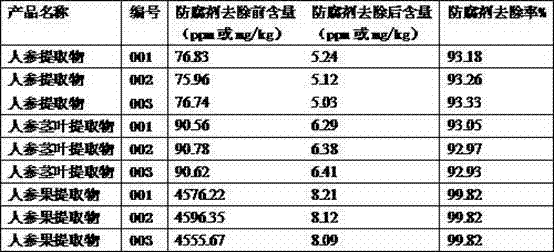Method for reducing antiseptic residue in extract of ginseng, ginseng leaf, ginseng stem, and ginseng fruit
A technology for extracting ginseng and ginseng stems and leaves, which is applied in the field of medicine and health, and can solve problems such as application and export restrictions of ginseng-related products, economic losses, etc.
- Summary
- Abstract
- Description
- Claims
- Application Information
AI Technical Summary
Problems solved by technology
Method used
Image
Examples
Embodiment 1
[0035] The preparation method of ginseng extract to reduce preservatives:
[0036]Receive raw ginseng (raw and sun-dried ginseng) 500kg. Take tap water with 18 times the amount of raw material (raw sun-dried ginseng), adjust the pH value to 10-12 with sodium carbonate, and mix well. Put the raw material (raw and sun-dried ginseng) into the prepared alkaline solution, and soak all the ginseng in the alkaline solution, rinse with a liquid circulation pump, and fully wash for 10-15 minutes. Drain the alkaline solution from the washed ginseng, wash the ginseng with tap water until the pH value of the washing solution reaches 7-8, add an appropriate amount of tap water to the washed ginseng to make it moist, cut into thick slices, and set aside. Put the sliced ginseng into the extraction tank, add water to decoct twice, add 15 times the amount of ginseng in tap water for 2 hours, add 12 times the amount of ginseng in tap water for 1.5 hours, and filter the decoction , combined ...
Embodiment 2
[0038] The preparation method of ginseng stem and leaf extract reducing preservatives:
[0039] Get 500kg of raw ginseng stems and leaves (dried ginseng stems and leaves), take tap water 25 times the amount of raw materials (dried ginseng stems and leaves), adjust the pH value to 10-12 with sodium carbonate, and mix well. Put the raw materials (ginseng stems and leaves) into the prepared alkaline solution, and soak all the ginseng stems and leaves in the alkali solution, rinse with a liquid circulation pump, and fully wash for 10-15 minutes. Drain the alkaline solution from the washed ginseng stems and leaves, and wash the ginseng stems and leaves with tap water until the pH value of the washing solution reaches 7-8. Put the processed ginseng stems and leaves into the extraction tank, add water to decoct twice, add 18 times the amount of ginseng stems and leaves in tap water for 2 hours, and add 15 times the amount of ginseng stems and leaves in tap water for 1.5 Hours, filte...
Embodiment 3
[0041] The preparation method of ginseng fruit extract reducing preservatives:
[0042] Receive 500kg of fresh ginseng juice, add 3-5% calcium hypochlorite, keep stirring, and mix thoroughly for 20-30 minutes. Adjust the pH value of the processed raw materials to 9-10 with sodium carbonate, mix well, and let stand for 10 minutes. Add hot water at 80-90°C to 18 times the amount of raw materials to dilute, the diluted solution is 80-90°C, separate the diluted solution from solid to liquid, discard the separated solid, add sulfurous acid to the separated liquid Mix iron (0.1g / kg) and settle for 6 hours. Pass the settled supernatant through HPD-100 macroporous adsorption resin column (resin consumption is 500kg), DM130 macroporous adsorption resin column (resin consumption is 250kg) (the flow rate of the upper column is controlled at 2BV / h), Elute with water until colorless, then elute with 65% ethanol, collect the 65% ethanol eluate, recover ethanol, and concentrate the filtrat...
PUM
 Login to View More
Login to View More Abstract
Description
Claims
Application Information
 Login to View More
Login to View More - R&D
- Intellectual Property
- Life Sciences
- Materials
- Tech Scout
- Unparalleled Data Quality
- Higher Quality Content
- 60% Fewer Hallucinations
Browse by: Latest US Patents, China's latest patents, Technical Efficacy Thesaurus, Application Domain, Technology Topic, Popular Technical Reports.
© 2025 PatSnap. All rights reserved.Legal|Privacy policy|Modern Slavery Act Transparency Statement|Sitemap|About US| Contact US: help@patsnap.com

